![]()
Exit Block Signals have, like other signal types, undergone changes during the time they have appeared in the Danish State Railway's rulebook. The rules for the Exit Block Signals probably haven't changed much but the actual use of the signals has.
The first Exit Block Signals were used where today's Platform Exit Signal is the standard; as a combined departure and semi block signal in station areas. This has been the most wide-spread use of Exit Block Signals through time:

Most such applications originate from changes to existing interlockings featuring Exit Route Signals and Exit Signal or Exit Signals only. Most of these "older" style Exit Block Signals have now been replaced with newer interlockings and the standard Platform Exit and Exit Signals, but a few remain, primarily around the Copenhagen Suburban Railway where they originated. However, some newer interlockings has brought this use of the Exit Block Signal back
In "modern" times the Exit Block Signal has found a slightly different walk of life as a signal helping break long stations into smaller blocks. The Exit Block Signal is mostly being referred to by this "modern" function, even though it is quite rare. The "modern" Exit Block Signal is a signal that is inserted between Platform Exit Signals and the Exit Signal on long stations to create an in-station block. Typically a long station has a group of switches at the end of the "Platform Tracks" (see definition below) and another group of switches at the end of the station, i.e. shortly before the Exit Signal. The Exit Block Signal is placed before the last group of switches, permitting a train to leave the platform tracks and proceed to the outer switch group, thus creating the in-station block. The usually fairly short block created between the Exit Block and the Exit Signals is similar to the block between Platform Exit and Exit Signals on normal length stations:

"Platform tracks" are station tracks that can hold a train being stopped
for operational purposes like exchange of passengers, a meet or to be overtaken.
A platform track need not actually have a platform to fit the definition.


The 2-lamp type is used on the Copenhagen Suburban Railway only. This type was the first in service and descends from the single-arm semaphore signal. The 3-lamp type is used on all other lines. There has previously been a number of single-arm semaphore Exit Block Signals, also on non-suburban lines, but these are all long out of service. Many of these installations were only intermediate during resignaling.
Exit Block Signals may have a supplementary Route Destination Indicator, a Reduced Speed Sign or a Numerical Speed Indicator. Currently no Exit Block Signal with Numerical Speed Indicator is in service.


It is common on larger stations to find Exit Block Signals with a Dwarf Signal at its foot. This is due to the fact that Exit Block Signals have no significance to switching moves. The Dwarf Signal, on the other hand, has no real significance to trains. Both signals operate in main routes.
 |
 |
 |
 |
|
|
X | X | X | X |
 |
 |
 |
 |
|
|
X | X | X | X |
 |
 |
 |
 |
|
|
X | X | X | X |
|
X | X | X | X |
|
X | |||
|
X | X | X | X |
|
X |
 |
 |
 |
 |
|
|
X | X | X | X |
|
X | X | X | X |
|
X | |||
|
X | X | X | X |
|
X |




The introduction of multiple aspect signaling and the much closer headways possible on the line also created a need for a more smooth station signaling. The Danish State Railways has in newer times preferred to interface station interlockings and line block systems by locating an Exit Signal on the "boundary" between the two systems, a strategy known in a number of other countries as well. With the Exit Signal outside the switch group following the platform tracks, and another signal at the end of the platform tracks, an in-station block could be created. Though the in-station block often was rather short, it actually equaled many open-line blocks in length on these densely trafficked lines:



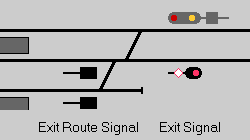
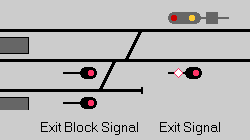
The only technical difference between Exit Route and Exit Block Signals is that the Exit Block Signals are constantly lit:
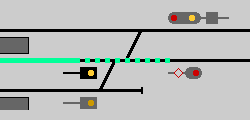
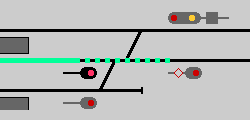
The real gain of converting Exit Route Signals to Exit Block Signals is that the Exit Block Signal can allow a train to proceed from the platform track to the Exit Signal even if the first block on the line is occupied. This is not possible with Exit Route Signals since the "Route Set" indication implies that the Exit Signal shows at least "Proceed":
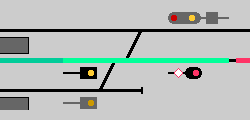
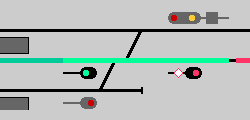
Another gain of the replacement is the elimination of the - since 1953 - illogical use of steady green for a signal aspect advance signaling the next signal to show at least "Proceed":
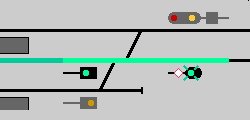
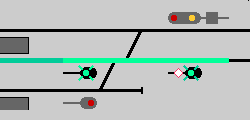
One can wonder why some Exit Route Signals were converted into Platform Exit Signals and some were converted into Exit Block Signals. From a technical point of view these conversions were almost identical and fairly simple. The answer perhaps lies in the fact that the Platform Exit Signal with its normal "No Passing" default indication wasn't really considered a Main Signal, and thus not used for these conversions where headway reduction was the goal. Later on, the Platfrom Exit Signal became the standard signal for these applications, and the Exit Route to Exit Block Signal conversions ceased.
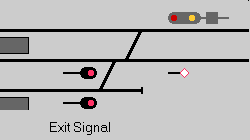

For incoming trains on an entry route there is no real difference:
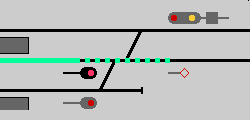

For exiting trains the change comes in two steps:
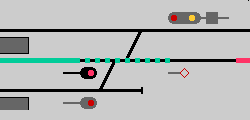

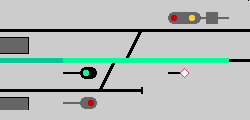

For some reason Gentofte got an electromechanical interlocking, probably the last that was ever installed. Lyngby got a state-of-the-art relay interlocking and signaling. It is likely that the interlocking in Gentofte was a re-use of a fairly new interlocking from Fyn, where the whole line was being converted into CTC.
The interesting thing about Gentofte is that while the station itself is rather trivial, the platform track signals are not. In both through tracks are Exit Block Signals to keep down the headway, as outlined above . For some reason the siding got Exit Route Signals, maybe a leftover from the re-used interlocking. These Exit Route Signals were probably the last to be installed (original station layout shown):

The Exit Block Signal in track 2 (middle) is located shortly after the end of the platform. This leaves the rest of track 2 as a safety overlap, facilitating simultaneous entry of an opposing train into the siding:

This arrangement utilizes the whole length of the siding for a long freight train to be overtaken while still keeping up the high traffic capacity in the Through Tracks.
Gentofte had its siding removed in 1998 and is for all practical matters abandoned as a station. Today the interlocking only remains to avoid having to rebuild the aging line block. At some point in time the southern (leftmost) tail track was removed. The corresponding Exit Route Signal was then converted into an Exit Block Signal since an Exit Route Signal is not able to provide the necessary flank protection for trains in track 2.
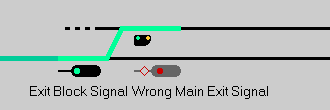
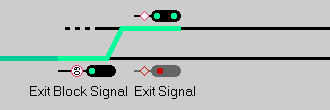
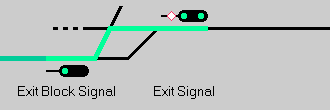

Since freight trains depart from the yard, Platform Exit Signals are installed here. On the right main from the passenger station is an Exit Block Signal, permitting trains to leave the passenger tracks and pull out to the outer switch group. The Exit Block Signal is not strictly necessary from a headway point of wiev, since the distance to the Exit Signal is relatively small, but an exit route directly to the Exit Signal would block the switch group for other use. In this example, the Exit Block Signal has been located sufficiently far from the switch group to keep the safety overlap from blocking the switches, thus permitting other movements in the switch group as well as permitting the train to continue in any direction:

The Platform Exit Signal remains at "Proceed" until the Exit Signal clears:


For trains headed towards wrong main, the more restrictive signaling on secondary exit routes comes into action. The Exit Block Signal only shows "Proceed" even though the Wrong Main Exit Signal also shows "Proceed":

Alternatively it is possible to by-pass the Exit Block Signal if so desired:

![]()
| [Back] | [Home] |
![]()